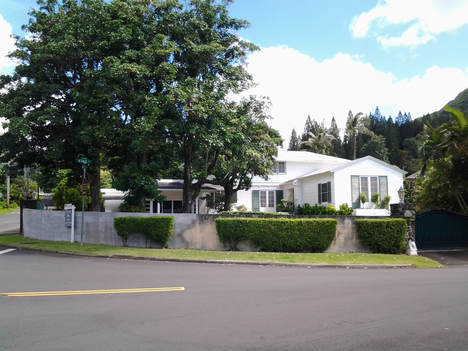Last month I had the pleasure of being in Hawaii for the Garden Club of Honolulu meeting. It was a treat to be back among old friends and familiar neighborhoods. As such, I thought it might be fun to reminisce on one “local” Hawaiian garden for this month’s GCD eNews.
The accompanying photos show my former home and garden in the Nu’uanu Valley. Named “Waipuna” which means “Spring Water” in Hawaiian, it is a unique piece of property, situated along the Nu’uanu Stream, and registered under the US National Register of Historic Places.
Beginning with a little bit of Hawaiian history, though today most of us are privileged to own our own land, the concept of private property was unknown to ancient Hawaiians. The island of Oahu was divided into six “moku.” Each moku was further divided into multiple “ahupua`as” which followed the natural boundaries of watershed areas. Geometrically, an ahupua`a looked like a wedge of land running from the mountain crest of the Ko’olau range all the way down to the sea.
Each ahupua’a was designed to be a self-sustaining unit. reflecting the resources of the area. Poorer agricultural regions were split into larger ahupua`as to compensate for the relative lack of natural resources. Inhabitants from shore areas could trade fish for crop food or wood with natives living upslope. Hawaiians understood the important inter-relationship between nature and mankind. Stewardship of the land and its resources was always a paramount theme. Enforcement was maintained by the kahuna (Hawaiian priests) via the “kapu” system. For example, restrictions might be placed on gathering certain plants or on fishing certain species during specific seasons. In this way, the community could maintain a sustainable lifestyle. By sharing resources and constantly working within the rhythms of their natural environment, Hawaiians enjoyed a good quality of life. Sounds like a good conservation recipe, don’t you think?
And now, back to “Waipuna”…Though the original property included 40 acres, by the time we purchased it in the 80’s, the property had been subdivided many times and was down to less than an acre. The Colonial Revival home was thoughtfully designed in 1934 by architect Roy Kelley, and built by CW Dickey for James L. Coke, the first territorial judge in Hawaii. Judge Coke went on to serve as the first Chief Justice of the Hawaii Supreme Court, appointed first by President Woodrow Wilson and then reappointed by President Franklin D. Roosevelt. The original landscape was designed by Richard Tongg, a prominent horticulturalist and landscape architect of the period, known for his vision of “Tropicalia” —meaning creating gardens with a “tropical attitude.” Mimicking native Hawaiian rain forests, parameters of his style included: lush jungle-like density of planting, a selection of large-leaved plants, the growth of vines creeping up tree trunks, use of iconic tropical species such as palms, bamboos, orchids and ferns, plant types with bold and colorful flowers and foliage, varied trees and garden ornaments derived from materials commonly found within the islands.
True to the spirit of the place, throughout the many years we owned the property, we worked very hard to create diverse garden areas, while trying to stay ahead of overgrowth! Many of you have heard me describe the machete as our favorite gardening tool! When I was assigned to map the grounds for my GCA provisional-year project, the only way I could figure out how to approach it was to divide the total area into 10 different zones! It is fun now to look back over my plant diary, which included grasses such as Mondo and Bermuda; a variety of trees such as Tecoma, Bamboo, Strawberry Guava, Plumeria, Gold, Hau, Kukui, Magnolia, Koa, Lychee, Coral, Autograph, Hawthorn, and Cypress; Plant selection included Hibiscus, Poinsettia, Paper Gardenia,Spider Gardenia, Leea, Ixora, Azalea, Begonia, Plumbago, Ginger, Heliconia, Anthurium, Orchids, Impatiens, Bougainvillea, Day Lilies, Palms and Bromeliads—to name a few!
But most importantly, we always felt tremendous responsibility to be good caretakers of the land and did our best to be conscientious stewards of the Nu’uanu Valley. This even extended way up stream, beyond our property, where my husband would often hike to insure the ancient water irrigation channels (known as auwai) stemming from the mountain waterfalls and the Nu’uanu Stream remained open, and that water (“wai”) could flow unobstructed and continue all the way down the valley to residents located below us. Sadly, it appears that no one is doing this in our area anymore, as our beautiful koi and lily ponds along the banks of the stream have dried up and are gone. Yet we remain philosophically hopeful—as Hawaiian waters are still considered to be sacred. We trust conservation measures will continue to prevail, though they may look different from what we knew in the past.

